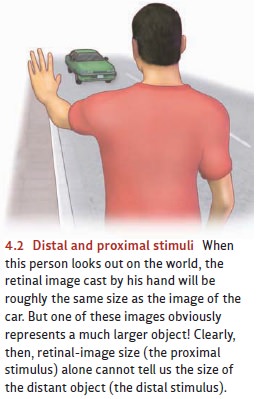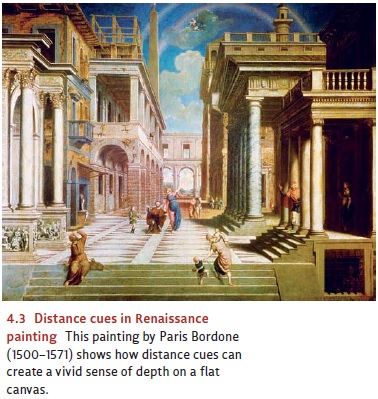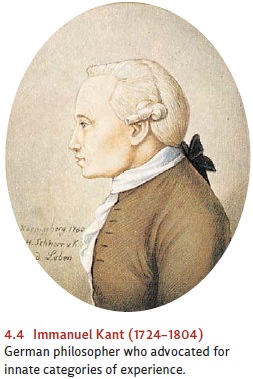Chapter: Psychology: Sensation
The Origins of Knowledge
THE ORIGINS OF KNOWLEDGE
Where does human knowledge come
from? One possibility is that our knowledge comes directly from the world
around us, and that our eyes, ears, and other senses are simply collecting the
information the world provides. According to this view, our senses faithfully
receive and record information much as a camera receives light or a microphone
receives sound, and this implies that our perception of the world is a rela-tively
passive affair. After all, a camera doesn’t choose which light beams to
receive, nor does it interpret any of the light it detects. Instead, it simply
records the light available to it. Likewise, a microphone doesn’t interpret the
speech or appreciate the music; again, in a passive way, it simply receives the
sounds and passes them along to an amplifier or recording device. Could this be
the way our vision and hearing work?
The Passive Perceiver
Advocates for the philosophical
view known as empiricism argued that
our senses are passive in the way just described. One of the earliest
proponents of this position was the 17th-century English philosopher John
Locke. He argued that at birth, the human mind is much like a blank tablet—a tabula rasa, on which experience leaves
its mark (Figure 4.1).

Let us suppose the mind to be, as
we say, a white paper void of all characters, without any ideas:—How comes it
to be furnished? Whence comes it by that vast store which the busy and
boundless fancy of man has painted on it with an almost endless variety? Whence
has it all the materials of reason and knowledge? To this I answer, in one
word, from experience. In that all our knowledge is founded; and from that it
ultimately derives itself. (Locke, 1690)
To evaluate Locke’s claim,
however, we need to be clear about exactly what information the senses receive.
What happens, for example, when we look at another person? We’re presumably
interested in what the person looks like, who he is, and what he’s doing. These
are all facts about the distal stimulus—the
real object (in this case, the person) in the outside world. (The distal
stimulus is typically at some distance from the per-ceiver, hence the term distal.)
But it turns out that our
information about the distal stimulus is indirect, because we know the distal
stimulus only through the energies that actually reach us—the pattern of light
reflected off the person’s outer surface, collected by our eyes, and cast as an
image on the retina, the light-sensitive tissue at the rear of each eyeball.
This input— that is, the energies that actually reach us—is called the proximal (or “nearby”)stimulus.
The distinction between distal
and proximal stimuli is crucial for hearing as well as vision. We hear someone
speaking and want to know who it is, what she’s saying , and whether she sounds
friendly or hostile. These are all questions about the speaker herself, so they
’re questions about the distal stimulus. However, our percep-tion of these
points must begin with the stimulus that actually reaches us—the sound-pressure
waves arriving at our eardrums. These waves are the proximal stim-ulus for
hearing.
The distinction between distal
and proximal stimuli is a problem for empiricists. To see why, let’s look at
the concerns raised by another empiricist philosopher, George Berkeley. As
Berkeley pointed out, a large object that’s far away from us can cast the
same-size image on our retina as can a small object much closer to us (Figure
4.2). Retinal-image size, therefore, doesn’t tell us the size of the distal
object. How, then, do we tell the large objects in our world from the small?
Berkeley also knew that the retina is a two-dimensional sur-face, and that all
images—from near objects and far—are cast onto the same plane. He argued,
therefore, that the retinal image cannot directly inform us about the
three-dimen-sional world. Yet, of course, we have little difficulty moving
around the world, avoiding obstacles, grasping the things we want to grasp. How
can we explain these abilities in light of the limitations of proximal stimuli?


The empiricists’ answer to these
questions boils down to a single word: learning.
We can perceive and move around in the three-dimen-sional world, they argued,
because our experience has taught us
how to interpret the two-dimensional proximal stimulus. To see how this
interpretation unfolds, consider the role of depth cues contained within the retinal image. These cues include
what’s called visualperspective—a cue
used to convey depth in many paintings (Figure4.3). The empiricists argued
that, in many circumstances, we see the pattern of visual perspective and a
moment later reach for or walk toward the objects we’re viewing. This
experience creates an associa-tion in the mind between the visual cue and the
appropriate move-ment; and because this experience has been repeated over and
over, the visual cue alone now produces the memory of the movement and thus the
sense of depth. In this way, our perception is guided by the proximal stimulus and the association.
The Active Perceiver
Other philosophers soon offered a
response to the empiricist position, arguing that the perceiver plays a much
larger role than the empiricists realized. In this view, the perceiver does far
more than supplement the sensory input with associations. In addition—and more
important—the perceiver must categorize and interpret the incoming sensory
information.

Many scholars have endorsed this
general position, but it’s often attributed to the German philosopher Immanuel
Kant (1724–1804; Figure 4.4). Kant argued that per-ception is possible only
because the mind organizes the sensory information into cer-tain preexisting
categories. Specifically, Kant claimed that each of us has an innate grasp of
certain spatial relationships, so that we understand what it means for one
thing to be next to or far from another thing, and so on. We also
have an innate grasp of temporal relationships (what it means for one event to
occur before another, or after) as well as what it means for one
event to cause another. This basic understanding of space, time, and causality
brings order to our perception; without this framework, Kant argued, our
sensory experience would be chaotic and meaningless. We might detect the
individual bits of red or green or heavy or sour; but without the framework
supplied by each perceiver, we’d be unable to assemble a coherent sense of the
world.
Notice that, in Kant’s view,
these categories (Kant called them “forms of apperception”) are what make
perception possible; without the categories, there can be no perception. The
categories must be in place, therefore, before any perceptual experi-ence can
occur, so they obviously can’t be derived
from perceptual experience. Instead, they must be built into the very
structure of the mind, as part of our biological heritage.
Related Topics